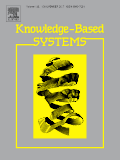
Knowledge Based Systems (KBS) - Volume 133 论文列表
| 点击这里查看 Knowledge Based Systems 的JCR分区、影响因子等信息 |
| 卷期号: Volume 133 |
| 发布时间: 1 October 2017 |
| 卷期年份: 2017 |
| 卷期官网: https://www.sciencedirect.com/journal/knowledge-based-systems/vol/133/suppl/C |
本期论文列表
Editorial Board
Univariate and Multivariate Time Series Manifold Learning
Hierarchical task network planning with resources and temporal constraints
Long range dependence in texts: A method for quantifying coherence of text
Leveraging question target word features through semantic relation expansion for answer type classification
Granular Fuzzy Possibilistic C-Means Clustering approach to DNA microarray problem
Predicting information diffusion probabilities in social networks: A Bayesian networks based approach
Multi-lingual and Cross-lingual timeline extraction
Multi-expert performance evaluation of healthcare institutions using an integrated intuitionistic fuzzy AHP&DEA methodology
Heuristically repopulated Bayesian ant colony optimization for treating missing values in large databases
Learning fuzzy semantic cell by principles of maximum coverage, maximum specificity, and maximum fuzzy entropy of vague concept
Actionable strategies in three-way decisions
Possibilistic activity recognition with uncertain observations to support medication adherence in an assisted ambient living setting
Fit evaluation of virtual garment try-on by learning from digital pressure data
Mining semantic association rules from RDF data
Private classification with limited labeled data
Adaptive density peak clustering based on K-nearest neighbors with aggregating strategy
Robust classification of biological samples in atomic force microscopy images via multiple filtering cooperation
Interpretable interval type-2 fuzzy predicates for data clustering: A new automatic generation method based on self-organizing maps
Detecting and predicting the topic change of Knowledge-based Systems: A topic-based bibliometric analysis from 1991 to 2016
Bidirectional possibilistic dominance in uncertain decision making
Cooperative two-engine multi-objective bee foraging algorithm with reinforcement learning
An entropy-based density peaks clustering algorithm for mixed type data employing fuzzy neighborhood

